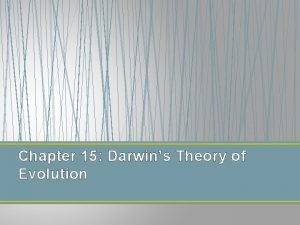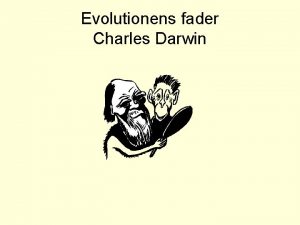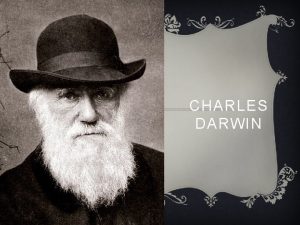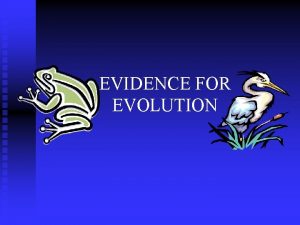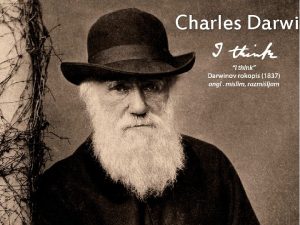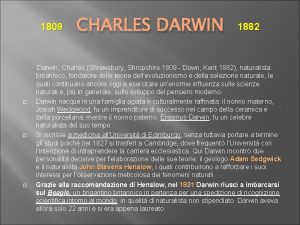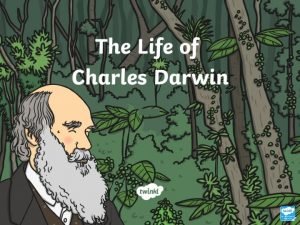Evolution Human Origins Who was Darwin Charles Darwin











- Slides: 11

Evolution

Human Origins Who was Darwin? • Charles Darwin – The Father of Evolution • 1809 – 1882 • The Origin of the Species 1859 • Darwin was a devout Christian, and did not see conflict with his theories and Christianity. He believed that God put us here, and the process of natural selection took over. • His theory is NOT “survival of the fittest” in terms of fighting it out. In essence, it’s a very random process. • Darwin thought that traits blended like paint in a new offspring and that some traits have greater “force” than others. He had no understanding of modern genetic theory like dominant and recessive genes, traits do not mix, etc.

• Natural Selection: some traits allow certain species to survive to procreating age better than other traits. • Example: Long legged deer have an easier time getting around in deep snow than short-legged deer. Their chances for survival are increased because they can escape predators easier than short-legged deer and can find more food. Their increased chances of surviving to the age of procreation meant that their offspring will inherit their long legs, thereby passing on the dominant trait that helps their survival. • Natural selection does NOT mean that shortlegged deer will grow longer legs.

The 3 parts of Natural Selection • Heritability: that organisms inherit characteristics from their parents • Variation: that there is a lot of variation within a species. Example: children are not carbon copies of their parents. • Environmental Fitness: those traits that allow an individual to survive to reproductive age are more likely to be passed on. They must survive in their environment until they reproduce.

• The Importance of the Peppered Moth – There are two types of peppered moths; one is white, one is black. – Pre-Industrial Revolution: the white moth would be better camouflaged against the white walls of buildings than the black moths. Consequently, the black moths were eaten by predators and did not survive to reproductive age. – Industrial Revolution: the buildings became black with soot and the black moths were better camouflaged than the white moths. The white moth population was then affected. – The peppered moth is now mostly of the white variety, as they’ve stopped using so much coal and have built bigger chimneys.

• Name two types of evidence for evolution • * see Human Evolution – A Possible Model Handout • Fossil, bone, stone remains • Microscopic analysis – pollen, scratches on bone • A. stands for Australopithicus – which is Latin for: • “Southern Ape” • What is the “missing link” or common ancestor? • Sahelanthropus Tchadensis

HUMAN VARIATION AND EVOLUTION • Our bodies are essentially 50, 000 years old. Now culture, not physical evolution, enables us to adapt very quickly to a changing environment. • Race • Cultural construct – does not physically exist – Ex. Ancient Egyptians – 4 races: golden, white, yellow and black – Hitler created the Aryan race

Legitimate explanations for human variation • Vitamin D and skin colour – Sunlight is the best source of vitamin D (necessary for healthy bones) – People with pale skin more readily absorb vitamin D than those with darker skin – Darker skin also provides better protection from UV rays – Paler skin is found in areas further from the equator where there is less sunlight

Lactose Intolerance – In Baltimore, a study found that 85% of black children and 17% of white children were lactose intolerant – Lactose intolerance in adult mammals is, in fact, normal – Some cultures (further from the equator) developed a biological situation – to produce lactase into adulthood – Many cultures (closer to the equator) developed cultural adaptations instead. Ex. yogurt contains lactobacillus, a bacteria that allows lactose to be digested – Current theory suggests that lactose is like Vitamin D; it allows the absorption of calcium. In areas with less sunlight, those who can absorb lactose (and calcium) more readily are more likely to survive to reproductive age, creating whole populations with lactose tolerance in adulthood.

Sickle Cell Anemia and Malaria – Sickle cell anemia is a rare disease (less than 1% of the world’s population) that inhibits the body’s processing of oxygen and iron, affecting all systems and lowering life expectancy – People with sickle cell anemia are less likely to die from malaria – Very common (often 20%) in populations where malaria is common – Africa – Still common among descendants of African slaves in America

 Charles darwin theory of evolution
Charles darwin theory of evolution H
H Chapter 15 darwin's theory of evolution
Chapter 15 darwin's theory of evolution Chapter 17 darwins theory of evolution
Chapter 17 darwins theory of evolution Chapter 15 darwin's theory of evolution section review 15-1
Chapter 15 darwin's theory of evolution section review 15-1 Chapter 15 darwin's theory of evolution section review 15-1
Chapter 15 darwin's theory of evolution section review 15-1 Chapter 15 darwin's theory of evolution
Chapter 15 darwin's theory of evolution Homologous structures example
Homologous structures example Endosymbiont theory
Endosymbiont theory Evolutionens fader
Evolutionens fader Where was charles darwin born
Where was charles darwin born Where was charles darwin born
Where was charles darwin born




